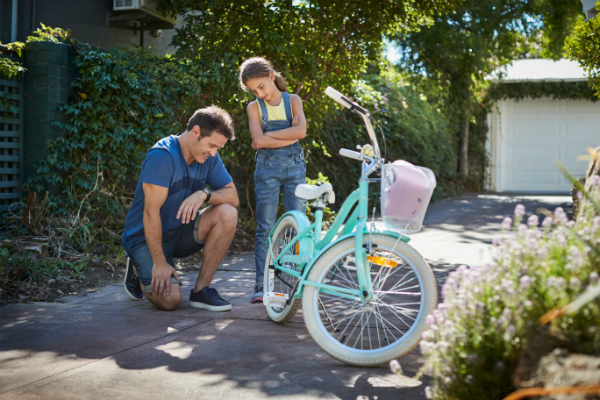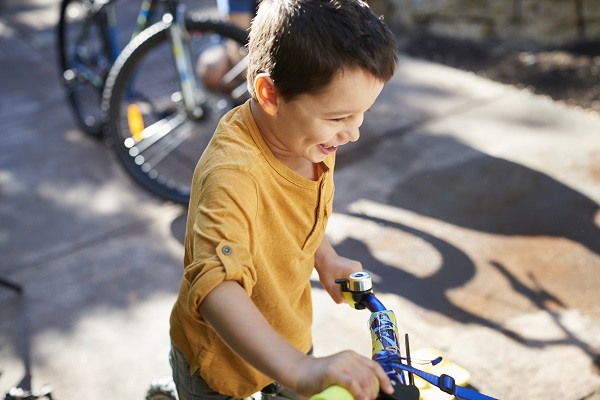A guide to teaching your child how to ride a bike
When new parents picture their baby growing up, a common moment to anticipate is teaching them to ride a bike. But, when the time comes, many don’t know where to start. How old should the child be? Should they ease into riding with training wheels or a balance bike, or just ‘dive in’ with a pedal bike? Will starting on grass help or hinder? Which rules apply to children and bikes? This comprehensive guide will help you teach your little one to ride with as few tears (yours and theirs) as possible.

Benefits of bikes
Besides having fun, children benefit in many ways from learning to ride a bike. While some benefits are relevant to beginner riders, other will become more relevant as children develop increased proficiency and independence.
It’s recommended that children do 60 minutes of physical activity each day, but many don’t reach this target. Riding a bike is great way to increase physical activity, leading to muscle development and improving cardiovascular fitness, balance, posture and coordination. Regular physical activity can also help reduce stress, anxiety and depression, and lead to better quality sleep. Riding may also help children, including those with ADHD, focus in the classroom, and improve their confidence, decision making skills and resilience.
Riding a bike is a fun activity to do as a family or with friends, and is a great way to encourage children to spend time outdoors. Riding around the neighbourhood helps children become familiar with their surrounds and get to know other kids in the area. As children get older, cycling can give them a sense of freedom and independence, and can even relieve parents of some chauffeuring duties. Cycling is also a cost-effective and environmentally friendly way to travel.
Ready, steady, go!
Considering these three factors will improve your chances of a successful start: your child’s readiness, ensuring you have appropriate equipment, and scouting an ideal location to start.
Ready or not?
Many children will start with a trike, balance bike, or a handle bike pushed by an adult. These vehicles are great fun and help children develop muscles, coordination and confidence. But there comes a time when each child is ready to take the next step and learn to ride a pedal bike on their own. Assessing when your child is ready to learn is essential to getting off to a great start. There is no right age to learn, and pushing a child who is not ready can lead to frustration and failure. Most kids will be ready to ride somewhere between the ages of 4 and 7. Children need to be physically ready, with appropriately developed muscles and coordination skills to manoeuvre the bike. They also need to feel ready and confident, with a desire to do it themselves and some awareness of danger. Children who see their parents, friends and older siblings cycle, or who have been riding as a passenger, may be more interested in learning at a younger age. If you think your child is ready, or they’ve shown a desire to learn, give it a go. If you find you aren’t making progress, you can always take a pause and try again at a later date.
The right stuff
Starting with the right size bike can greatly improve your chance of a successful start. Talking to an expert at a specialist bike shop is the best way to ensure the right fit. It’s tempting to size up so the bike will last longer, but this can hinder the child’s ability to ride and stop safely. Your child’s feet should be able to touch the ground on both sides of the bike in case they need to stop in an emergency, or balance while they’ve stopped.
Make sure the bike meets current safety standards:
- A red rear reflector on the back
- A working bell, horn or similar warning device
- A white front lights and read rear light
- At least one effective brake
- Yellow pedal reflectors on each wheel
- Two yellow reflectors on each wheel
If choosing a second-hand bike, ensure the bike is in good condition. Check the wheels hold pressure, the brakes work, and all parts are sturdy and free of rust. A specialist bike shop can check or service a bike if you’re unsure. With any new or second-hand bike, regular checks and maintenance are needed to maintain good working order. To check your bike safety, refer here.
Your child must learn to ride wearing a helmet that adheres to the Australian and New Zealand safety standard (AS/NZA 2063). Helmets are a legal requirement and protect your child’s head in case of a fall. Even if you’re just in the backyard, wearing a helmet from the start helps kids form good safety habits. A well-fitting helmet will sit two finger widths above the eyebrows and will not move forwards or backwards. The side strap should form a V shape around the bottom of your child’s ears, and the strap under the chin should fit snuggly, with no more than one finger able to fit under the strap. Second-hand helmets are not recommended, as internal damage can be invisible. For added safety, elbow pads, knee pads and wrist guards can be worn.
Most young children’s bikes are fitted with coaster brakes (also known as back-pedal brakes or foot brakes) which are activated by pedalling backwards. Make sure you discuss these features with your child before they start riding. Your child’s clothing can also help improve their safety; they should wear brightly coloured clothing that does not hang down, as well as enclosed footwear. Pants and long-sleeved clothes may help protect from minor scrapes.
Location, location
The next thing to consider is where to begin your lesson. A gradual, smooth, grassy slope with a level area at the bottom is ideal. This will allow the child to get some momentum, but reduce the chance of losing control. Starting on grass provides a softer landing for the inevitable spills. If a suitable grassy area is not available, a smooth, sealed path is your next best choice. Don’t choose a location that is very busy, as the child may get distracted, embarrassed, or collide with a person or object. Your child should not be riding in or near pedestrian, cyclist or road traffic until they have developed the skills to effectively balance, steer and stop.
Step to it
There are a number of skills your child needs to master to successfully ride a pedal bike on their own:
- Starting
- Balancing
- Pedalling
- Stopping
- Steering
Some children will find different skills more difficult than others, and how quickly they pick up each skill will depend on the type of bike they have been riding previously. For example, if your child has been riding a balance bike, they may have already mastered the balance part of riding, and the challenge will be to maintain this balance while pedalling. If your child has been riding with training wheels, they most likely can already pedal, but will need to master balancing the bike without the training wheels as support. The following steps are a guide only, and you will need to modify your training based on how well your child picks up the skills, and how they feel during the training. Work at your child’s pace, keep it fun, and maintain a positive and encouraging attitude. If you or your child becomes upset or frustrated, take a break and pick it up again another day. It may take several attempts to complete all the steps below.
Step 1.Starting
You may prefer to use a flat area for this step. Align the pedals so one is in the 1 o’clock position (slightly forward of the upright position), the other pedal will be in the 7 o’clock position. Your child should place one foot flat on the ground, and the other foot on the higher pedal. As they push down on the high pedal, they will need to quickly lift the balancing foot to the other pedal and start pedalling. This may take a few tries, and it’s ok to help them balance until they can do it alone. Each time they restart, ensure the pedals are returned to the correct starting position, as this will give them the most momentum from the first pedal.
Step 2.Balancing
If your child’s bike has gears, ensure the bike is on a low/easy gear setting. Start at the top of the light slope, with your child on the bike. Hold your child’s shoulders or waist for balance, but not the bike. They should be holding the handlebars straight and resting their feet on the pedals. Let go (or give a little push) and let them coast down the slope, balancing the bike on their own. At the bottom they will naturally slow and can use their feet to stop themselves.
Step 3.Pedalling
Continue having your child coast down the slope and encourage them to pedal when they feel ready. As your child pedals, they may throw their weight from side to side, so remind them to keep the handlebars even.
Step 4. Stopping
Using the same slope to pedal down the hill, encourage your child to try and stop themselves without putting their feet down. Remind them that they can pedal backwards to activate the brake (or squeeze the hand brake), then put their feet down for balance when they stop.
Step 5. Steering
Riding in a straight line won’t be fun forever, so the next step is learning to steer. This should come quite intuitively, but will require some practice to get the timing and force right. Start by riding in large circles, so they only need to turn gradually. As they get more comfortable steering, they can ride in smaller circles, figure eights and around obstacles.

Keep it up
Congratulations, your child has now mastered the basics of riding a pedal bike. But remember, it’s not unusual for children to regress or plateau, especially if they don’t practice for a while or when they face a new challenge, like riding uphill. Each time you ride, start somewhere safe (like your front yard or a park) to ‘warm up’ before expecting your child to ride in a crowded or difficult location. As you continue practicing, your child will gradually develop the skills, strength and confidence to ride further and in different locations. Remember, children under 10 years old should be actively supervised when riding a bike, and older if the child is new to riding or lacks proficiency.
Brush up on the rules
Do you know the rules that apply to cyclists? Before you and your child ride in or near pedestrian or motor traffic you’ll need to brush up on the rules that keep you and others safe. Your child will learn the rules as much from copying you as from what you tell them. For example, if you tell your child that helmets are mandatory, but they see you riding without one, they may not take the rule seriously, so it’s important to always model the behaviour you want them to follow. Read more detail about rules. A great way to practice road rules in a safe way is to check out a bike skills track which gives kids the chance to practice following the road rules, without the hazards of real traffic. As well as the legal rules, it’s a great idea to set your own rules before you ride, so your child understands what behaviour is expected.